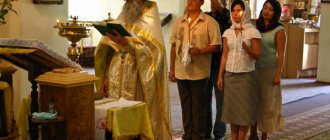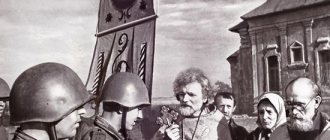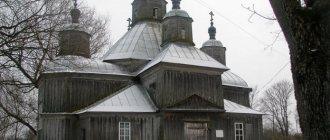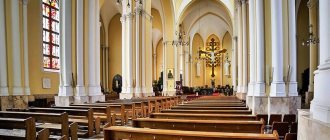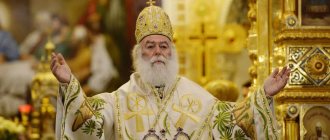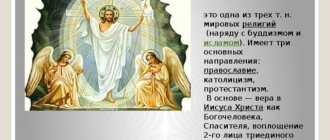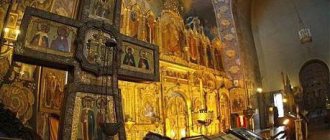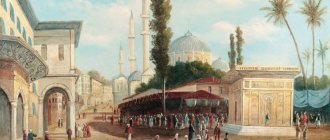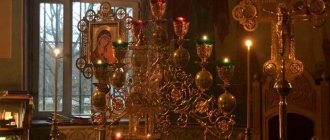Orthodox Church: structure, areas of activity, sources of funding
In the Old Russian state, the church was headed by the Kiev Metropolitan, appointed from Constantinople or by the Prince of Kyiv, followed by the election of bishops at a council.
In large cities, bishops were in charge of all church affairs. Hierarchs could own lands, cities, and villages. The church had its own court and legislation, which made it possible to intervene in all aspects of the life of its parishioners. The power of the church was based on its rapidly growing material income. Vladimir Svyatoslavovich established the “tithe”.
Definition 1
“Tith” is the deduction of a tenth of the prince’s income to the benefit of the church.
Relying on material wealth, the church acquired influence on political and economic life, on the life of the population. She sought to act as a guarantor of inter-princely agreements, fixed by the “kiss of the cross”, intervened in negotiations, and church representatives often took on the role of ambassadors.
Are you an expert in this subject area? We invite you to become the author of the Directory Working Conditions
The Orthodox Church used various methods to preach its doctrine and establish authority. A major role in this was played by the construction of temples, the architectural form and internal painting of which symbolized the “earthly” and “heavenly” worlds. For the purpose of religious influence on human consciousness, services and rituals were performed. Prayers for recovery, victory over enemies, and salvation from natural disasters were held in churches, sermons and teachings were delivered. With the help of confession, churchmen penetrated into the inner world of parishioners, influenced their actions and found out information about plans against the church, the ruling class and the social system.
Despite the fact that during the period of feudal fragmentation Christianity had already embraced most of the population, even among the nobility there was disdain for religion and disrespect for the clergy. Among the people, resistance to Christianity was even greater.
Church leaders tried to strengthen the position of the church; it turned into a source of Christianization of other peoples. At the same time, there was an interpenetration of individual elements of religious ideology and cult as a result of the broad interrelations of Kievan Rus.
Finished works on a similar topic
Course work The role of the church in the Old Russian state 430 ₽ Abstract The role of the church in the Old Russian state 240 ₽ Test work The role of the church in the Old Russian state 250 ₽
Receive completed work or specialist advice on your educational project Find out the cost
Under Vladimir, the church was in charge of some worldly affairs related to state interests. The Church received jurisdiction over all Christians (family matters, cases of “violation of the sanctity and inviolability of Christian churches and symbols,” apostasy, “offensive moral feelings”). Also, a special society was placed under church care, separated from the flock - almshouse people. They included:
- white clergy with families;
- clergy;
- monks;
- priest widows and adult priests;
- wanderers;
- bread;
- people staying in hospices and hospitals, and those who served them;
- “inflated people”, beggars, outcasts, the population of church lands.
1. Brief history of the Russian Orthodox Church
. 2. The structure of the Russian Orthodox Church. 3. His Holiness Patriarch of Moscow and All Rus'. 4. Charter of the Russian Orthodox Church. 5. Fundamentals of the Social Concept of the Russian Orthodox Church. 6. Fundamentals of the teaching of the Russian Orthodox Church on dignity, freedom and human rights. 7. Official website of the Russian Orthodox Church. 8. Official website of the St. Petersburg Metropolis. 9. Official website of the Vyborg diocese.
A BRIEF HISTORY OF THE RUSSIAN ORTHODOX CHURCH.
The Russian Orthodox Church has a history of more than a thousand years. According to legend, the holy Apostle Andrew the First-Called, preaching the Gospel, stopped at the Kyiv Mountains and blessed the future city of Kyiv. The spread of Christianity in Rus' was facilitated by its proximity to a powerful Christian power - the Byzantine Empire. The south of Rus' was sanctified by the activities of the holy Equal-to-the-Apostles brothers Cyril and Methodius, apostles and educators of the Slavs. In 954, Princess Olga of Kiev was baptized. All this prepared the greatest events in the history of the Russian people - the baptism of Prince Vladimir and the Baptism of Rus' in 988. In the pre-Mongol period of its history, the Russian Church was one of the metropolises of the Patriarchate of Constantinople. The metropolitan who headed the Church was appointed by the Greek Patriarch of Constantinople, but in 1051 the Russian Metropolitan Hilarion, the most educated man of his time and a remarkable church writer, was first installed on the high priestly throne. Since the 10th century, majestic temples have been built. Since the 11th century, monasteries began to develop in Rus'. In 1051, the Monk Anthony of Pechersk brought the traditions of Athonite monasticism to Rus', founding the famous Kiev-Pechersk Monastery, which became the center of the religious life of Ancient Rus'. The role of monasteries in Rus' was enormous. And their main service to the Russian people - not to mention their purely spiritual role - is that they were the largest centers of education. In the monasteries, in particular, chronicles were kept that brought to this day information about all significant events in the history of the Russian people. Icon painting and the art of book writing flourished in the monasteries, and translations of theological, historical and literary works into Russian were carried out. The extensive charitable activities of monastic monasteries contributed to the cultivation of the spirit of mercy and compassion among the people. In the 12th century, during the period of feudal fragmentation, the Russian Church remained the only bearer of the idea of the unity of the Russian people, counteracting the centrifugal aspirations and civil strife of the princes. The Tatar-Mongol invasion - the greatest disaster that befell Rus' in the 13th century - did not break the Russian Church. She remained as a real force and was a comforter to the people in this difficult trial. Spiritually, materially and morally, she contributed to the restoration of the political unity of Rus' - the key to future victory over the enslavers. The unification of disparate Russian principalities around Moscow began in the 14th century. And the Russian Church continued to play an important role in the revival of a united Rus'. Outstanding Russian saints were the spiritual leaders and assistants of the Moscow princes. Saint Metropolitan Alexy (1354-1378) raised the holy noble prince Demetrius Donskoy. He, like later Saint Metropolitan Jonah (1448-1471), by the power of his authority helped the Moscow prince in ending feudal unrest and preserving state unity. The great ascetic of the Russian Church, St. Sergius of Radonezh, blessed Demetrius Donskoy for the greatest feat of arms - the Battle of Kulikovo, which served as the beginning of the liberation of Rus' from the Mongol yoke. Monasteries greatly contributed to the preservation of the national identity and culture of the Russian people during the difficult years of the Tatar-Mongol yoke and Western influences. In the 13th century, the beginning of the Pochaev Lavra was laid. This monastery and its abbot, Reverend Job, did a lot to establish Orthodoxy in Western Russian lands. In total, from the 14th to the half of the 15th century, up to 180 new monastic monasteries were founded in Rus'. The largest event in the history of ancient Russian monasticism was the founding of the Trinity-Sergius Monastery by St. Sergius of Radonezh (around 1334). Here, in this later famous monastery, the wondrous talent of the icon painter St. Andrei Rublev blossomed. Freed from the invaders, the Russian state gained strength, and with it the strength of the Russian Orthodox Church grew. In 1448, shortly before the fall of the Byzantine Empire, the Russian Church became independent of the Patriarchate of Constantinople. Metropolitan Jonah, installed by the Council of Russian Bishops in 1448, received the title of Metropolitan of Moscow and All Rus'. Subsequently, the growing power of the Russian state contributed to the growth of the authority of the Autocephalous Russian Church. In 1589, Moscow Metropolitan Job became the first Russian Patriarch. The Eastern Patriarchs recognized the Russian Patriarch as fifth in honor. The 17th century started out hard for Russia. Polish-Swedish invaders invaded Russian Land from the west. During this time of unrest, the Russian Church, as before, honorably fulfilled its patriotic duty to the people. The ardent patriot Patriarch Ermogen (1606-1612), tortured by the interventionists, was the spiritual leader of the militia of Minin and Pozharsky. The heroic defense of the Trinity-Sergius Lavra from the Swedes and Poles in 1608-1610 is forever inscribed in the chronicle of the history of the Russian state and the Russian Church. In the period following the expulsion of the interventionists from Russia, the Russian Church dealt with one of its very important internal problems - the correction of liturgical books and rituals. Much of the credit for this belonged to Patriarch Nikon. The beginning of the 18th century was marked for Russia by the radical reforms of Peter I. The reform also affected the Russian Church: after the death of Patriarch Adrian in 1700, Peter I delayed the election of a new Primate of the Church, and in 1721 established a collegial higher church administration represented by the Holy Governing Synod, which remained the highest church body for almost two hundred years. During the Synodal period of its history (1721-1917), the Russian Church paid special attention to the development of spiritual education and missionary work on the outskirts of the country. The restoration of old and the construction of new temples was carried out. The beginning of the 19th century was marked by the activities of remarkable theologians. Russian church scientists did a lot for the development of such sciences as history, linguistics, and oriental studies. The 19th century gave great examples of Russian holiness: the outstanding hierarchs, Metropolitans of Moscow Philaret and Innocent, St. Seraphim of Sarov, the elders of the Optina and Glinsk hermitages. At the beginning of the twentieth century, preparations began for the convening of the All-Russian Church Council. The Council was convened only after the February Revolution - in 1917. His greatest act was the restoration of the Patriarchal administration of the Russian Church. Metropolitan Tikhon of Moscow was elected at this Council as Patriarch of Moscow and All Rus' (1917-1925). Saint Tikhon made every effort to calm the destructive passions fanned by the revolution. The Message of the Holy Council dated November 11, 1917 said: “Instead of the new social structure promised by the false teachers, there is a bloody feud among the builders; instead of peace and brotherhood of peoples, there is confusion of languages and bitter hatred of brothers. People who have forgotten God rush at each other like hungry wolves... Leave the crazy and wicked dream of false teachers who call for the implementation of world brotherhood through world civil strife! Return to the path of Christ!' For the Bolsheviks, who came to power in 1917, the Russian Orthodox Church was a priori an ideological enemy. That is why many bishops, thousands of priests, monks, nuns and laity were subjected to repression, including execution and murders that were shocking in their cruelty. When in 1921-22 the Soviet government demanded the release of valuable sacred objects, things came to a fatal conflict between the Church and the new government, which decided to use the situation for the complete and final destruction of the Church. By the beginning of World War II, the church structure throughout the country was almost completely eliminated. There were only a few bishops left free who could perform their duties. In the entire Soviet Union, only a few hundred churches were open for worship. Most of the clergy were in camps, where many were killed or disappeared. The catastrophic course of hostilities for the country at the beginning of World War II forced Stalin to mobilize all national reserves for defense, including the Russian Orthodox Church as a popular moral force. Temples opened for worship. The clergy, including bishops, were released from the camps. The Russian Church did not limit itself only to spiritual support for the cause of defending the Fatherland in danger - it also provided material assistance, including uniforms for the army, financing the tank column named after Dmitry Donskoy and the squadron named after Alexander Nevsky. The culmination of this process, which can be characterized as the rapprochement of the state and the Church in “patriotic unity,” was Stalin’s reception on September 4, 1943 of the Patriarchal Locum Tenens Metropolitan Sergius (Stragorodsky) and Metropolitans Alexy (Simansky) and Nikolai (Yarushevich). From this historical moment, a “thaw” began in relations between the Church and the state, but the Church was constantly under state control, and any attempts to expand its activities outside the walls of the temple met with unyielding resistance, including administrative sanctions. The position of the Russian Orthodox Church was difficult during the period of the so-called “Khrushchev Thaw”, when thousands of churches throughout the Soviet Union were closed for the sake of ideological principles. The celebration of the Millennium of the Baptism of Rus' in 1988 marked the decline of the state-atheist system, gave new impetus to church-state relations, forced those in power to begin a dialogue with the Church and build relationships with it on the principles of recognition of its enormous historical role in the fate of the Fatherland and its contribution to the formation of moral foundations of the nation. The true return of the people to the Father's house began - people were drawn to Christ and His Holy Church. Archpastors, pastors, and laity began to work zealously to recreate full-blooded church life. At the same time, the absolute majority of clergy and believers showed extraordinary wisdom, endurance, steadfastness in faith, devotion to Holy Orthodoxy, despite neither the difficulties with which the revival was associated, nor the attempts of external forces to split the Church, undermine its unity, deprive it of internal freedom, and subjugate it. worldly interests. Even the collapse of the Soviet Union in 1991, accompanied by a widespread increase in national egoism, could not destroy the multi-ethnic nature of the Moscow Patriarchate. The desire to enclose the Russian Orthodox Church within the framework of the Russian Federation and the national diasporas associated with it has so far proven futile. However, the consequences of the persecution turned out to be very, very serious. It was necessary not only to restore thousands of churches and hundreds of monasteries from ruins, but also to revive the traditions of educational, educational, charitable, missionary, church and public service. Metropolitan Alexy of Leningrad and Novgorod, who was elected by the Local Council of the Russian Orthodox Church to the First Hierarchal See, widowed after the death of His Holiness Patriarch Pimen, was destined to lead the church revival in these difficult conditions. On June 10, 1990, the enthronement of His Holiness Patriarch of Moscow and All Rus' Alexy II took place. Under his First Hierarchal omophorion, the Russian Orthodox Church undertook the most difficult efforts to recreate what was lost during the years of persecution. Peculiar milestones on this difficult path were the Bishops' Councils of the Russian Orthodox Church, at which current problems of church revival were freely discussed and decisions were made on canonical, disciplinary and doctrinal issues. The Bishops' Council of the Russian Orthodox Church on March 31 - April 5, 1992, held in Moscow, made a number of important decisions regarding church life in Ukraine and the canonical position of the Ukrainian Orthodox Church. At the same Council, the beginning was laid for the glorification of the holy new martyrs and confessors of Russia, who suffered for Christ and His Church during the years of persecution. In addition, the Council adopted an appeal in which it outlined the position of the Russian Orthodox Church on issues that worried society in the countries in which its flock lives. The Council of Bishops of the Russian Orthodox Church on June 11, 1992 was convened on an extraordinary basis to consider the case on charges of Metropolitan Philaret of Kyiv in anti-church activities that contributed to the split of the Ukrainian Orthodox Church. In a special “Judicial Act,” the Council decided to depose Metropolitan of Kyiv Philaret (Denisenko) for committing grave moral and canonical crimes and causing a schism in the Church. The Bishops' Council of the Russian Orthodox Church on November 29 - December 2, 1994, in addition to a number of decisions concerning internal church life, adopted a special definition 'On the relationship of the Church with the state and secular society in the canonical territory of the Moscow Patriarchate at the present time', in which it confirmed the 'non-preference' for the Church of any political system, political doctrine, and so on, the inadmissibility of the Church's support of political parties, and also prohibited clergy from nominating themselves for elections to local or federal authorities. The Council also decided to begin developing “a comprehensive concept reflecting the church-wide view on issues of church-state relations and the problems of modern society as a whole.” The Council especially noted the need to revive the missionary service of the Church and decided to develop a concept for the revival of the missionary activity of the Russian Orthodox Church. In pursuance of the decisions of the Council of Bishops in 1994, the Holy Synod in December 1995 decided to form the Missionary Department of the Moscow Patriarchate. The Council of Bishops of the Russian Orthodox Church on February 18 - 23, 1997 continued work on the church-wide glorification of the new martyrs and confessors of Russia. In addition, the themes discussed at the Council of Bishops in 1994, which outlined the most important tasks and trends in church life, were developed in council reports and discussions. In particular, the Council confirmed the inviolability of the church position on the issue of the inadmissibility of participation of the Church and its ministers in political struggle. In addition, the prospects for the participation of the Russian Orthodox Church in international Christian organizations, problems of missionary and social service of the Church, threats to the proselytizing activities of heterodox and heterodox religious associations were discussed. The Anniversary Council of Bishops of the Russian Orthodox Church met on August 13-16, 2000 in the Hall of Church Councils of the recreated Cathedral of Christ the Savior. The meetings of the Council, which ended with the solemn consecration of the Temple, were included in the circle of celebrations dedicated to the great Jubilee - the 2000th anniversary of the Coming of our Lord and Savior Jesus Christ into the world. The Council became a unique phenomenon in the life of the Russian Orthodox Church in terms of the number and significance of the decisions it made. According to the report of Metropolitan Yuvenaly of Krutitsy and Kolomna, Chairman of the Synodal Commission for the Canonization of Saints, a decision was made to glorify for church-wide veneration in the ranks of saints the Council of New Martyrs and Confessors of Russia of the 20th century, known by name and hitherto unknown to the world, but known to God. The Council considered materials about 814 ascetics whose names are known, and about 46 ascetics whose names could not be established, but about whom it is reliably known that they suffered for the faith of Christ. The names of 230 previously glorified locally venerated saints were also included in the Council of New Martyrs and Confessors of Russia for church-wide veneration. Having considered the issue of canonization of the Royal Family, the members of the Council decided to glorify Emperor Nicholas II, Empress Alexandra and their children: Alexy, Olga, Tatiana, Maria and Anastasia as passion-bearers in the Council of New Martyrs and Confessors of Russia. The Council made a decision on the general church glorification of the ascetics of faith and piety of other times, whose feat of faith was different from that of the new martyrs and confessors. The members of the Council adopted the Basic Principles of the Russian Orthodox Church’s attitude towards heterodoxy, prepared by the Synodal Theological Commission under the leadership of Metropolitan Philaret of Minsk and Slutsk. This document became a guide for clergy and laity of the Russian Orthodox Church in their contacts with non-Orthodox people. Of particular importance is the adoption by the Council of the Fundamentals of the social concept of the Russian Orthodox Church. This document, prepared by the Synodal Working Group under the leadership of Metropolitan Kirill of Smolensk and Kaliningrad and the first document of its kind in the Orthodox world, sets out the basic provisions of the teaching of the Church on issues of church-state relations and on a number of modern socially significant problems. The document reflects the official position of the Moscow Patriarchate in the field of relations with the state and secular society. In addition, a new charter of the Russian Orthodox Church was adopted at the cathedral, prepared by the Synodal Commission for Amendments to the Charter on the Office of the Russian Orthodox Church under the leadership of Metropolitan of Smolensk and Kaliningrad Cyril. The church is currently guided by this charter. The cathedral adopted a message to the God -loving shepherds, honest inemics and all the faithful children of the Russian Orthodox Church, the definition of the Ukrainian Orthodox Church, the definition of the position of the Orthodox Church in Estonia and the definition of issues of the internal life and external activities of the Russian Orthodox Church.
The role of the church court
In 1019, Yaroslav the Wise ascended the throne. The church is already there by this time, and Yaroslav continues the work begun by his father. In the decree developed, it preserves the cases within the jurisdiction of the church and, in clearly formulated theses, describes the procedure for legal proceedings with a system of punishments.
The system is built on the distinction between sin and crime. “Sin is not only a moral crime of the law, but also the thought of an act by which the sinner can cause harm. A crime is an act by which a person causes harm or injury to another person.” Yaroslav built his church-judicial order on these concepts. He divided all cases within the jurisdiction of the church into categories that provided for various penalties.
Spiritual matters not related to worldly laws were dealt with by the bishop's court without a princely judge. These included cases of violation of church commandments, such as witchcraft and sorcery.
Cases of “sinful criminality” were dealt with by the princely court with the participation of the church court. The princely court imposed a sentence, and the metropolitan received a small amount for the development of the church. This category included cases of “abuse of girls, insult by deed or word, spontaneous divorce of a husband from his wife due to the latter’s fault, violation of marital fidelity.”
Ordinary illegal actions committed by both laymen and church people were considered by the court of the church according to princely laws. The prince reserved his participation in the trial of the people of the church department. It was expressed in the fact that their serious crimes were tried in a church court with the participation of the princely judge, with whom the former shared the fines.
ACCEPTING CHRISTIANITY. THE ROLE OF THE CHURCH IN THE LIFE OF ANCIENT Rus'
The date of the introduction of Christianity as a state religion in Rus' is considered to be 988, when the Grand Duke of Kiev Vladimir and his retinue were baptized. Although the spread of Christianity in Rus' began earlier. In particular, Princess Olga adopted Christianity. Prince Vladimir sought to replace the pagan pantheon with a monotheistic (monotheism) religion.
The choice fell on Christianity because:
1) the influence of Byzantium was great in Rus';
2) the faith has already become widespread among the Slavs;
3) Christianity corresponded to the mentality of the Slavs and was closer than Judaism or Islam.
There are different points of view on how Christianity spread:
1) the baptism of Rus' took place peacefully. The new religion acted as a powerful unifying factor. (D.S. Likhachev);
2) the introduction of Christianity was premature, since the bulk of the Slavs continued to believe in pagan gods until the 14th century, when the unification of the country had already become inevitable. Adoption of Christianity in the 10th century. strained relations between the Kyiv nobility and its neighbors. The baptism of Novgorodians took place along with massive bloodshed, Christian rituals and customs did not take root in society for a long time: the Slavs called children pagan names, church marriage was not considered obligatory, and in some places remnants of the clan system (polygamy, blood feud) were preserved (I.Ya. Froyanov). Since the adoption of Christianity as the state religion, the Russian Church has been part of the Ecumenical Church of Constantinople. The metropolitan was appointed by the patriarch. Initially, the metropolitans and priests in Rus' were Greeks. But meanwhile, Russian foreign policy maintained its independence thanks to the firmness and tenacity of the first princes. Yaroslav the Wise appointed the Russian priest Hilarion as metropolitan, thereby putting an end to the dispute with the Greeks.
The Russian Church had a great influence on all spheres of life of the Slavs: politics, economics, culture:
1) the church began to quickly gain economic independence. The prince donated tithes to her. Monasteries, as a rule, ran extensive households. They sold some of their products on the market, and stored some of their products. At the same time, the Church grew richer faster than the great princes, since it was not affected by the struggle for power during feudal fragmentation, there was no great destruction of its material values even during the years of the Mongol-Tatar invasion;
2) political relations began to be illuminated by the church: relations of domination and subordination began to be considered as correct and godly, while the church received the right to reconcile, to be a guarantor, and a judge in the political sphere;
3) Christian churches became centers of not only religious, but also secular life, as community gatherings were held, treasury and various documents were kept;
4) the Christian Church made an important contribution to the culture of ancient Russian society: the first sacred books appeared, the monk brothers Cyril and Methodius compiled the Slavic alphabet. Among the population of Rus', especially the Principality of Kyiv, the percentage of literate people increased. Christianity introduced new standards of behavior and morality for the Slavs, such as “thou shalt not steal”, “thou shalt not kill”.
Periodization according to E.E. Golubinsky
Academician E.E. Golubinsky, more than others, connects the periodization of Russian church history with civil history. He distinguishes three periods in Russian church life: Kiev, Moscow and St. Petersburg. “If periods in the histories of societies are spaces of time, different from each other not by some external and random signs, but by the very life of societies and its character, then there are three such real, and not imaginary, periods in the history of the Russian Church: Kiev, Moscow and current Petersburg".
* * *
With all the diversity of approaches to the periodization of the history of the Russian Church, all of the above-mentioned historians can find common ground. Despite the great difference in the methodology of historical research, they all left behind their fame as discoverers of previously unknown sources and collectors of enormous church historical material. They often wrote differently about the same events, but now we see how their works complemented each other. Subsequent workers in the field of church historical science used the above examples of periodization of the history of the Russian Orthodox Church, sometimes slightly modifying or detailing the schemes of their great predecessors. Any periodization is always conditional to one degree or another. Therefore, reviewing the history of the Russian Church, one can consider the most important milestones in the history of church life in Russia.
2000th anniversary of the Nativity of Christ
In 2000, the entire Christian world celebrated the great anniversary of the Nativity of Christ. As a symbol of the spiritual revival of Russia, the Cathedral of Christ the Savior was restored. In 2000, the Jubilee Council of Bishops of the Russian Orthodox Church took place, at which more than 1,000 clergy, monastics and laity who suffered during the years of the terrible persecution of the 20th century were glorified in the host of new martyrs and confessors. The Council adopted the “Fundamentals of the Social Concept of the Russian Orthodox Church,” which set out basic provisions on issues of church-state relations and on a number of modern socially significant problems. On May 17, 2007, the historic reunification of the Russian Orthodox Church in the Fatherland and abroad took place: His Holiness Patriarch Alexy II of Moscow and All Rus' and Metropolitan Laurus signed an Act on the restoration of canonical communion between the two parts of the Russian Church. At the Local Council of the Russian Orthodox Church on January 27–28, 2009, His Holiness Patriarch Kirill of Moscow and All Rus' was elected to serve as Primate. 2014 marked the 700th anniversary of the birth of St. Sergius of Radonezh, the great lamp of the Russian Land, the collector of Muscovite Russia, who made a huge contribution to the liberation of Russia from a three-hundred-year yoke, to its spiritual and economic revival. In 2015, the Orthodox world celebrated another great anniversary - 1000 years since the death of Equal-to-the-Apostles Prince Vladimir, the Baptist of Russia, who made the main civilizational choice for us. Let us believe that the Lord, through the prayers of the Mother of God and all the saints who have shone in the Russian land, will preserve the Church and our country in peace and prosperity. “Holy Rus'! Keep the Orthodox Faith, in it lies your affirmation” (from the stichera to Russian saints).
